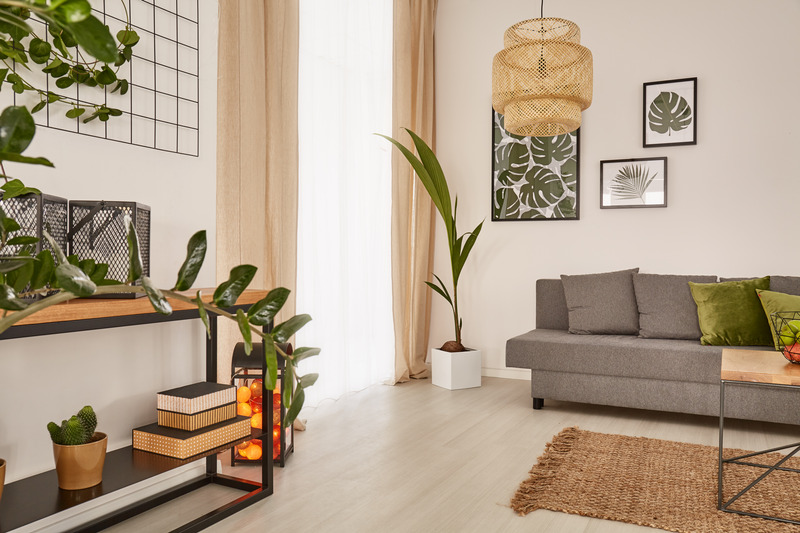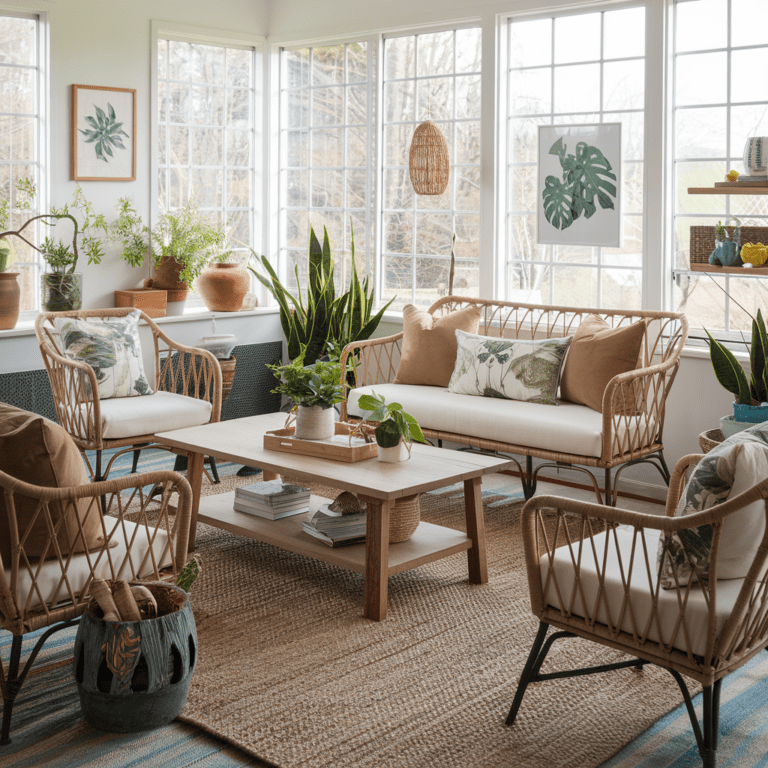Enhancing Your Home’s Beauty With Houseplants: 8 Indoor Plants That Provide Aesthetic Appeal
This post may contain affiliate links. As an Amazon Associate, I earn from qualifying purchases at no extra cost to you. Read my full disclosure.
Looking for a simple and affordable way to add color, texture, and life to your home décor? Look no further than houseplants!
Not only do indoor plants provide aesthetic appeal, but they also offer a range of health benefits, from improving air quality to reducing stress and increasing productivity.
Whether you have a green thumb or are just starting out, incorporating plants into your home décor is a fun and rewarding way to enhance your space and boost your well-being.
In this article, we’ll explore some tips and ideas for beautifying your home with houseplants.
Houseplants can add a lot of beauty and life to your home. Here are a few ways that they can make your home look more beautiful:
- Bring in color: Plants come in a variety of colors, from bright greens to deep purples. Adding a few plants with colorful leaves or flowers can add a pop of color to any room in your home.
- Add texture: Different types of plants have different textures, from smooth and shiny to rough and spiky. Mixing and matching plants with different textures can add interest and depth to your home décor.
- Create a focal point: A large, statement plant can serve as a focal point in a room, drawing the eye and creating a sense of visual interest.
- Soften hard edges: Plants can help to soften the hard edges of furniture and architecture in your home. Placing plants on bookshelves, window sills, or next to sharp angles can help to create a more organic, natural feel in your space.
- Bring the outdoors in: Houseplants can help to create a sense of nature and freshness in your home, especially if you live in an urban area or don’t have easy access to a lot of green space.
Overall, adding houseplants to your home can be an easy and affordable way to make your space look more beautiful and inviting.
When deciding which indoor plants to buy for your house, there are several factors to consider, including:
- Lighting conditions: Different plants have different light requirements, so it’s important to choose plants that will thrive in the lighting conditions of your home. For example, some plants require bright, direct sunlight, while others prefer lower light levels.
- Space availability: Consider the amount of space you have available for plants, as well as the size and shape of the plants you’re interested in. Some plants grow tall and narrow, while others spread out horizontally.
- Maintenance requirements: Some plants require more care and attention than others, so it’s important to choose plants that you feel comfortable taking care of. Factors like watering frequency, soil type, and pruning needs should be taken into account.
- Personal preferences: Ultimately, the plants you choose for your home should be ones that you enjoy and find aesthetically pleasing. And of course, as we’ve already mentioned consider factors like color, texture, and shape when selecting plants.
By taking these factors into account, you can choose the plants that are best suited to your home and lifestyle, ensuring that they thrive and add beauty to your space.
The Benefits of Indoor Plants
Research has suggested that having plants in your home can have a positive impact on your mental health and happiness.
One study, conducted by the University of Technology in Sydney, found that people who had plants in their homes reported lower levels of stress and higher levels of overall well-being compared to those who did not have plants in their homes.
There are many benefits of indoor plants, including:
- Air purification: Plants are natural air purifiers and can remove harmful pollutants from the air in your home, improving overall air quality.
- Stress reduction: Being around plants has been shown to reduce stress levels and promote relaxation, making them a great addition to any home or office.
- Increased productivity: Studies have found that having plants in the workplace can increase productivity and concentration levels, leading to better work performance.
- Improved health: Plants can have a positive impact on our physical health, including reducing symptoms of allergies and improving our overall immune system.
- Aesthetic appeal: Plants can add a touch of natural beauty to any space, bringing color, texture, and life to your home décor.
- Sound absorption: Certain plants, such as large-leafed varieties, can absorb sound waves and reduce noise levels in your home.
- Mood enhancement: Plants have been shown to improve mood and mental well-being, making them a valuable addition to any home or living space.
- Adding visual interest: Plants can add color, texture, and shape to your home décor, making it more visually interesting and appealing.
- Creating a natural atmosphere: Incorporating plants into your home can help to create a more natural and organic atmosphere, which can make your home feel more welcoming and inviting.
- Providing a sense of accomplishment: Caring for plants and watching them grow can be a satisfying and rewarding experience, providing a sense of accomplishment and pride.
Overall, adding indoor plants to your home can offer a range of benefits for both your physical and mental health, as well as enhance the aesthetic appeal of your space
Choose Safe Indoor Plants for Pets and Kids
If you have pets or kids it’s important to have safe indoor plants because some plants can be toxic or harmful if ingested.
Children and pets are often curious and may be attracted to colorful or interesting plants, and may unintentionally ingest them.
Symptoms of plant toxicity in pets may include vomiting, diarrhea, difficulty breathing, and seizures, while children may experience symptoms like nausea, vomiting, or skin irritation. In some cases, ingesting toxic plants can even be life-threatening.
To prevent accidental ingestion and keep your family and pets safe, it’s important to choose indoor plants that are non-toxic and safe for all members of your household.
This can include plants like spider plants, Boston ferns, and African violets, which are known to be safe for pets and children. We’ll discuss more on safe indoor plants later in this article.
In summary, choosing safe indoor plants is an important step in ensuring the health and safety of your family and pets, and can help you enjoy the benefits of indoor plants without any risks.
(If you don’t have kids or pets don’t worry! This doesn’t pertain to you and you have an even more larger selection of indoor plants to choose from)
Creative Ways to Decorate Your Home with Houseplants
Adding plants to your living room, bedroom, and throughout your home can enhance its appeal. Here are some creative ways to decorate your home with household plants:
- Hanging plants: Consider adding hanging plants to your decor by hanging them from the ceiling or placing them on a high shelf. This not only adds visual interest but also frees up valuable floor space.
- Terrariums: Terrariums are a great way to bring a small piece of nature indoors. You can create your own terrariums using various types of indoor plants, such as succulents or ferns, and display them on a coffee table or shelf.
- Planters with stands: Elevate your plants by placing them on decorative stands or pedestals. This not only adds height and dimension to your decor but also makes a statement piece out of your favorite plants.
- Wall-mounted planters: Use wall-mounted planters to create a living wall or to display a collection of small plants. This is a great way to bring the outdoors inside and add a pop of green to your decor.
- Clustered plants: Group plants of varying sizes and types together to create a lush, natural look. This also allows you to create different levels of greenery and texture in your space.
- Plants in unexpected places: Get creative and place plants in unexpected places, such as on bookshelves, in the bathroom, or even in the kitchen. This adds a touch of nature to every room and can help purify the air in areas where you may not expect to see plants.
By incorporating these creative ideas, you can enhance the aesthetic appeal of your home and bring the beauty of nature indoors with houseplants.
Here are some care tips for houseplants:
- Watering: The amount and frequency of watering depends on the type of plant and the environment. Overwatering may cause root decay and underwatering can cause wilting. It’s essential to research the specific needs of your plants and check the soil moisture regularly.
- Lighting: While some indoor plants may require low light conditions, most of them thrive in bright indirect light. Place your plants in the appropriate location based on their light needs, and rotate them periodically to ensure all parts receive adequate light.
- Humidity: Some houseplants, such as tropical plants, prefer high humidity. You can increase humidity by placing a tray of water near the plant or misting the leaves regularly.
- Fertilizing: Houseplants benefit from periodic fertilization to promote healthy growth. Use a well-balanced, water-soluble fertilizer according to the instructions on the package.
- Pruning: Regular pruning can assist in keeping the plants in the arrangement healthy and encouraging fresh growth. Eliminate any decaying or withering leaves, and trim excessive branches or stems.
- Cleaning: To maintain the health of indoor plants, it’s important to keep their leaves clean and free from dust. Dust can obstruct their ability to photosynthesize effectively. You can either mist the leaves with water or gently wipe them with a damp cloth to remove any dust buildup. This will help ensure that your plants stay healthy and vibrant.
By following these care tips, you can help your houseplants thrive and maintain their beauty and health.
8 Household Plants That Provide Aesthetic Appeal And Health Benefits
ZZ Plant
The ZZ plant, also known as the Zamioculcas Zamiifolia, is a popular houseplant that originates from Africa.
The ZZ plant is known for its glossy, dark green leaves and its ability to thrive in a low-light environment.
In addition to being an attractive plant for the home, the ZZ plant also has a number of benefits.
For starters, the ZZ plant is known for its ability to purify the air. In fact, according to my research, the ZZ plant has been shown to remove up to 86% of harmful toxins from the air.
The ZZ plant is also a very good choice for people who suffer from allergies or asthma, as it can help to improve air quality and reduce symptoms.
Lastly, the ZZ plant is virtually indestructible, making it a perfect choice for people who have little experience in taking care of plants or have a knack for killing them.
With its glossy leaves and air-purifying abilities, the ZZ plant is an ideal addition to any home.
Snake Plants
Snake plants are long and have thin leaves that are often variegated with green and white stripes.
Snake plants are easy to care for and they can tolerate a wide range of growing conditions.
They can be grown in both full sun and shade, and they require very little water. As a result, snake plants are an excellent choice for those who want to add a touch of greenery to their home.
In addition to being low-maintenance, snake plants also have a number of other benefits.
For example, they are known to improve air quality by filtering out pollutants such as carbon dioxide and formaldehyde.
Snake plants can also help to boost your mood and concentration levels, making them the perfect plant for your home or office.
Philodendron ‘Birkin’
Philodendron ‘Birkin’ is a hybrid plant that is becoming increasingly popular among plant enthusiasts.
While it is often grown as an ornamental plant, it also has a number of benefits. For instance, Philodendron ‘Birkin’ is known to be effective at filtering out formaldehyde and other VOCs from the air.
This can be helpful in improving indoor air quality. In addition, the plant is relatively low-maintenance and does not require a lot of care.
As long as it receives adequate sunlight and moisture, it will thrive. Philodendron ‘Birkin’ is a versatile plant that can be an asset to any home or office.
Money Tree
The money tree is a type of plant that is believed to bring good luck and fortune to those who own it.
Native to Central and South America, the money tree is a member of the fig family. The leaves of the money tree are typically green, but they can also be yellow, red, or brown.
The tree gets its name from the fact that its leaves resemble dollar bills. Money trees are popular houseplants, and they are known for being easy to care for.
In addition to being beautiful plants, money trees are also believed to have some special powers. For example, it is said that placing a money tree in a home or business will bring good luck and fortune.
It is also said that money trees can help to improve financial stability and attract positive energy.
Whether or not you believe in the powers of the money tree, there is no denying that these plants make beautiful and unique houseplants.
Peace Lily
The peace lily is a plant that is native to India. It has large, glossy leaves and white flowers that bloom throughout the year.
The peace lily is an easy plant to care for and is known for its ability to thrive in a low-light environment.
The plant also does not require a lot of water, making it a good choice for people who have busy schedules or who frequently travel.
In addition to being aesthetically pleasing, the peace lily also has several benefits. The plant helps to purify the air by removing harmful toxins such as formaldehyde and carbon monoxide.
The peace lily also produces oxygen, which can help to improve indoor air quality. As a result, the peace lily is not only beautiful but also beneficial to your health.
Peperomia
Peperomia is a group of perennial herbs with wide, fleshy leaves that are native to tropical areas.
These plants have a distinct look that makes them popular houseplants, and this plant is effortless to maintain and requires minimal care.
Peperomia is also known for its ability to purify the air, making them an ideal choice for homes or offices.
In addition, these plants can help to increase humidity levels, which can be beneficial for people who suffer from dry skin or sinuses.
Peperomia is available in a wide range of shapes and sizes, so there is sure to be a variety that is perfect for any home or office.
With their attractive foliage and air-purifying abilities, Peperomia is a very good choice for anyone looking for a low-maintenance houseplant.
Pothos
Another popular houseplant that is known for its ability to purify indoor air is called Pothos (Epipremnum aureum).
This hardy plant can thrive in a wide range of conditions, such as bright light, with low maintenance making it an ideal choice for beginner gardeners.
Pothos is often used as a trailing plant, and its attractive variegated leaves make it a popular addition to office and home décor.
In addition to its aesthetic appeal, pothos has been shown to remove harmful toxins from the air, including formaldehyde and xylene.
These pollutants are commonly found in carpets, paint, and cleaning products, and they have been linked to a variety of health problems.
By removing these toxins from the air, pothos can help to create a healthier indoor environment. Pothos are also easy to care for, requiring only occasional watering and care.
Parlor Palm
Parlor palms are a type of palm tree known for their tall, slender trunks and their large, frond-like leaves.
Parlor palms are prized for their beauty and their usefulness. The leaves can be used to make baskets, mats, and ropes, while the trunk can be used for construction purposes.
In addition, the fruits of the parlor palm are edible and have many health benefits. They are a good source of vitamins A and C, as well as potassium and fiber.
Furthermore, studies have shown that the extracts from parlor palms can help to lower blood pressure and cholesterol levels.
Consequently, these trees offer a wide range of benefits to both people and the environment.
Other houseplants to consider:
- Bamboo palm (Chamaedorea seifrizii)
- Boston fern (Nephrolepis exaltata)
- Areca palm (Dypsis lutescens)
- African violet (Saintpaulia)
- Christmas cactus (Schlumbergera)
- Friendship plant (Pilea involucrata)
- Ponytail palm (Beaucarnea recurvata)
- Swiss Cheese Plant (Monstera epipremnoides)
- Aloe vero (Aloe barbadenis miller)
- Fiddle leaf figs (Ficus lyrata)
Conclusion
Incorporating houseplants into your home decor not only enhances the aesthetic appeal of your space but also provides a multitude of health benefits.
From purifying the air we breathe to reducing stress and increasing productivity, there are countless reasons to bring nature indoors.
With the wide variety of non-toxic plant options available, it’s easy to find the perfect fit for your household and lifestyle.
By taking the time to care for these living organisms, you can create a vibrant and thriving indoor garden that not only beautifies your home but also supports your overall well-being.







